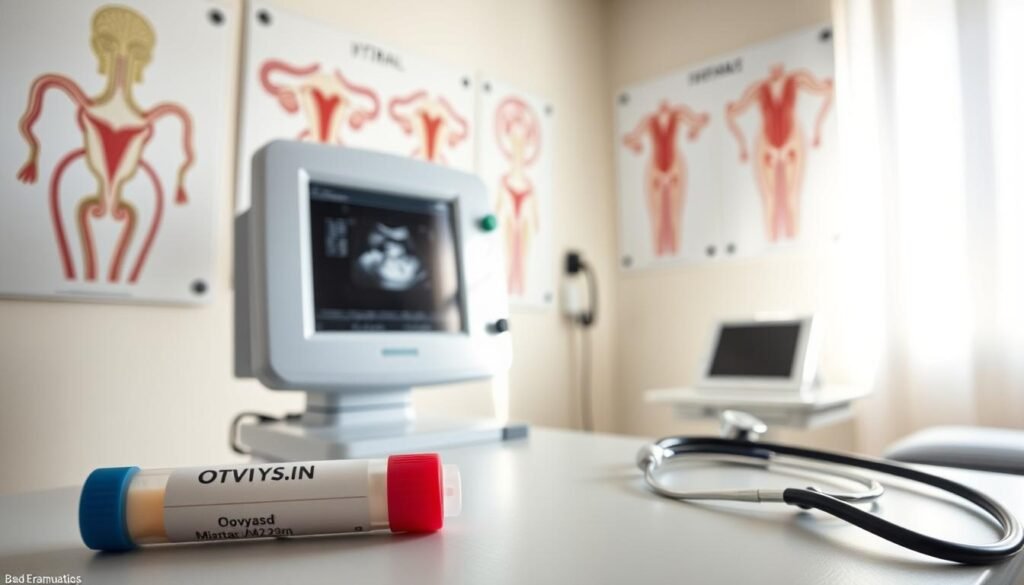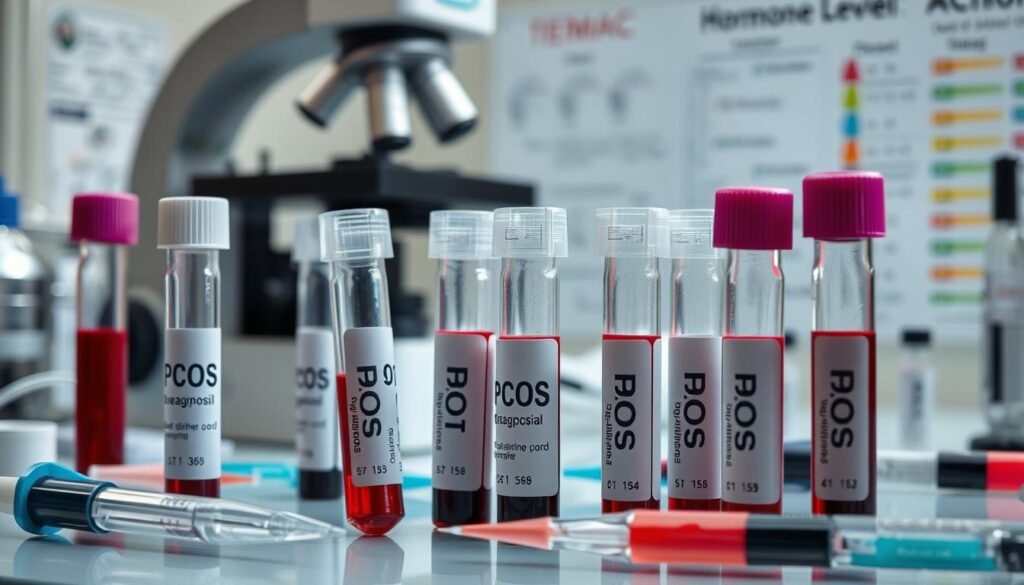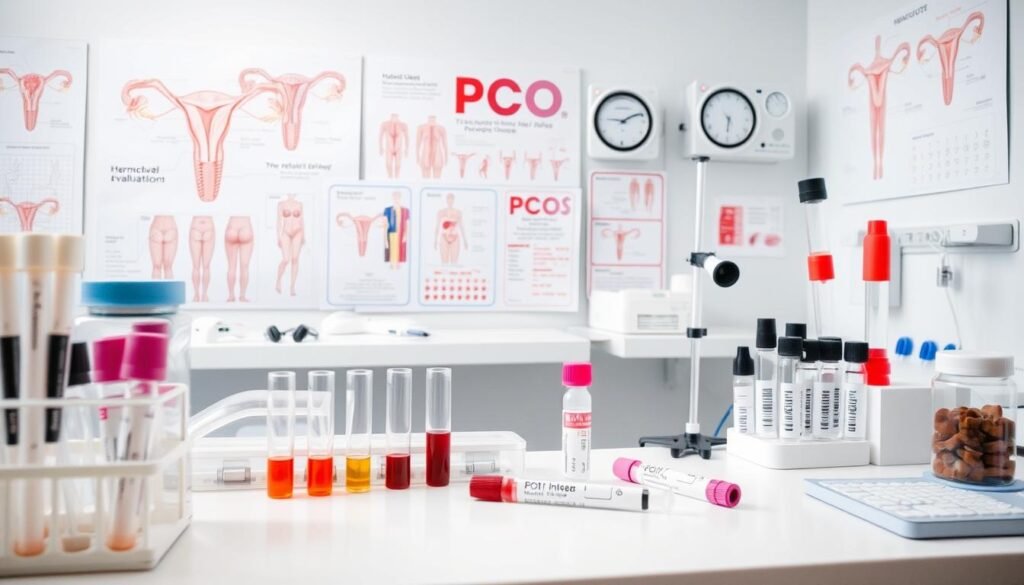About 1 in 10 women of childbearing age has Polycystic Ovary Syndrome (PCOS). It’s a condition that affects hormones. It can cause problems like irregular periods and insulin resistance. Knowing how to test for PCOS is key. Early detection can help women live better lives. Let’s talk about how doctors diagnose PCOS and what you might experience during a visit.
Those with PCOS show many different symptoms. To understand it, doctors look at your medical history and do physical exams and tests. It’s important to diagnose it correctly and early. This way, women can start improving their health sooner.
Key Takeaways
- PCOS affects about 1 in 10 women of childbearing age.
- The diagnosis typically involves criteria like irregular ovulation and increased androgen levels.
- Blood tests for hormone levels and insulin are essential in the diagnosis process.
- Pelvic ultrasounds are commonly performed to identify ovarian cysts.
- Early diagnosis can improve management and quality of life significantly.
Understanding PCOS: An Overview
Polycystic Ovary Syndrome (PCOS) is a health issue from hormonal imbalance in women. It mainly comes from too much male hormones, or androgens. Women with PCOS might have more hair growth, acne, gain weight, and have irregular periods.
A big issue with PCOS is insulin resistance. This issue can lead to a higher chance of getting type 2 diabetes. Knowing about PCOS helps people find treatment early on, which is very important.
People often start having PCOS signs in puberty or early adulthood. But sometimes, symptoms don’t show up until later. Knowing about PCOS overview helps women get help early. This early help can mean better diagnosis and treatment.
Managing PCOS well often means changing how you live, like losing weight through diet and exercise. Doctors might also suggest medicine to help with periods and getting pregnant. These steps can fight both hormonal issues and insulin problems, leading to a better life.
| Symptom | Description |
|---|---|
| Irregular Menstrual Cycles | Infrequent or prolonged menstrual periods |
| Excessive Hair Growth | Increased hair growth on the face and body |
| Acne | Common skin condition, often worsening with hormonal changes |
| Weight Gain | Difficulty maintaining a healthy weight due to metabolic changes |
| Insulin Resistance | Body’s diminished ability to respond to insulin, raising diabetes risk |
Getting to know more about understanding PCOS helps women manage their health better. This can lead to improved health overall.
Signs and Symptoms of PCOS
It’s very important to know the signs and symptoms of PCOS. This can help in treating and managing it properly. PCOS is common in women of reproductive age. It leads to different health issues, both physically and emotionally.
Irregular Menstrual Cycles
Having irregular menstrual cycles is a clear sign of PCOS. Someone with PCOS may have less than nine periods a year. These periods can be more than 35 days apart. The lack of regular ovulation makes it hard to have a normal cycle.
Excess Androgen Levels
High levels of androgens, or excess androgen levels, are a big part of PCOS symptoms. This can cause a lot of hair to grow on the face, chest, and back. This condition is known as hirsutism. Acne and scalp hair thinning are other issues. Blood tests are used to check for high hormone levels. These tests help connect hormone levels to physical changes.
Polycystic Ovaries
Having polycystic ovaries is another aspect of PCOS. This is seen through ultrasound exams. The exams show many small cysts or follicles on each ovary. But it’s key to remember that not everyone with PCOS has these cysts.
| Symptom | Description |
|---|---|
| Irregular Menstrual Cycles | Fewer than nine periods per year, often occurring more than 35 days apart. |
| Excess Androgen Levels | Increased facial and body hair, acne, and thinning scalp hair. |
| Polycystic Ovaries | Ultrasound may reveal multiple small cysts on the ovaries. |
Importance of Early Diagnosis
Early diagnosis in women with polycystic ovary syndrome (PCOS) is key to better health. Catching symptoms early lets doctors plan better treatments. This helps avoid serious problems later.
Women with PCOS are at higher risk for diabetes, high blood pressure, and heart disease. They have a higher chance of having a heart attack than women without PCOS.
Finding symptoms early is very important. Symptoms that seem like normal puberty can actually hide PCOS, making diagnosis take longer. Up to 75% of women with PCOS don’t know they have it. More awareness can help.
Knowing the risks of PCOS can lead to better lifestyle choices. Even losing a small amount of weight helps a lot. It can fix menstrual cycles and lower diabetes risk.
Early detection means a chance at a healthier life. Starting healthy habits early helps avoid worse problems later on.
How Do You Test for PCOS?
To check for PCOS, doctors use a detailed method. They look for signs of too much androgen and check menstrual cycles. They also use ultrasounds to see if ovaries are polycystic. The 1990 NIH consensus says you need two of these signs for a PCOS diagnosis:
- Clinical or biochemical signs of androgen excess
- Irregular ovulation
- Polycystic ovaries on an ultrasound
Doctors first talk to the patient to learn their medical history. They pay close attention to menstrual cycles and signs of high androgens. This could mean acne or too much hair growth. Blood tests for hormone levels and ultrasounds are important too.

Women with PCOS might have many tiny follicles on an ultrasound. They could have a high LH to FSH ratio too. Common signs are irregular periods or none at all. Blood tests can show if androgens are high. Ultrasounds confirm if ovaries are polycystic.
It’s important for those with PCOS to check their blood pressure, cholesterol, and blood sugar yearly. This is because PCOS increases the risk of diabetes and heart disease. Knowing how to test for PCOS helps people get the right treatment. They can make changes in their lifestyle to better their health.
The Role of Physical Exams in PCOS Diagnosis
Physical exams are crucial for diagnosing Polycystic Ovary Syndrome (PCOS). Doctors look for key signs like hirsutism and acne during these exams. These symptoms show hormone levels in the body. The importance of physical examinations is very high. They help doctors decide on the next steps for treatments.
It’s important to check the body mass index (BMI) of women with PCOS. Many women with PCOS struggle with their weight. Doctors also check for insulin resistance, common in PCOS patients. Through a complete hormonal assessment, they get a full picture of the patient’s health.
Finally, including physical exams in PCOS diagnosis is key. It helps spot symptoms and directs doctors on which tests to do next. This leads to better, specific treatments for patients.
PCOS Blood Tests: What You Need to Know
Understanding pcos blood tests is vital for anyone dealing with polycystic ovary syndrome. These tests check hormone levels and metabolic health. They are key in fully understanding the condition.
Measuring Hormone Levels
Blood tests are important for checking hormone levels, such as testosterone. They also look at reproductive hormones like FSH and LH. These tests show if you’re ovulating normally, which can explain menstrual problems seen with PCOS.
When you take these tests matters because hormone levels change during your cycle. You can find out more by visiting this resource.
Testing Insulin and Glucose Levels
Many with PCOS have metabolic issues, making testing insulin and glucose levels essential. These tests show how your body handles sugar and if you have insulin resistance. This problem is common in PCOS and can lead to diabetes and heart issues.
Regular monitoring can help you take steps to improve your health and life.

| Blood Test | Purpose | Typical Findings in PCOS |
|---|---|---|
| Testosterone | Measures androgen levels | Often elevated |
| FSH | Assesses follicle stimulation | Usually low or normal |
| LH | Evaluates luteinization | Typically increased |
| Insulin | Checks blood sugar response | May show elevated levels |
| Glucose | Assesses blood sugar levels | Potentially higher than normal |
These pcos blood tests are crucial for diagnosing and managing the syndrome effectively. They give doctors a clear view of a patient’s hormone and metabolic profile.
PCOS Ultrasound Scans Explained
PCOS ultrasound scans are key in checking for polycystic ovaries, often found in those with polycystic ovary syndrome. A transvaginal ultrasound is the top choice for ultrasound for PCOS diagnosis. It gives a clear picture of the ovaries. Doctors look for many small cysts in the ovaries during the scan, a sign common in PCOS patients.
To identify polycystic ovaries, doctors use specific criteria. Having at least 12 small follicles, or an ovarian volume over 10 cm³, hints at PCOS. Finding more than 25 follicles in the ovary also points to the condition.
PCOS ultrasound scans are very useful, but not always complete. Hormonal contraceptives might hide cysts, making the scans less clear. Doctors also use symptoms and lab tests for a full diagnosis.
Getting the whole picture is crucial for the right treatment plan. This approach ensures personalized care. For deeper understanding of PCOS, checking the causes and symptoms of PCOS is advised.
Hormonal Evaluations for PCOS Diagnosis
Hormonal analysis is key to identifying polycystic ovary syndrome (PCOS). Testing levels of androgens, like testosterone, is critical. High testosterone often points to PCOS. Health experts always check this in their hormone tests.
Hormone tests cover a range, including progesterone and estrogen, to assess ovarian function. This deep dive helps doctors understand a patient’s hormone balance. Spotting imbalances guides the creation of personalized treatment for PCOS.

Diagnosing PCOS involves several steps. Blood tests for hormone levels are crucial to pcos hormonal evaluations. Doctors also use physical exams and ultrasounds. With no single test for PCOS, a mix of methods is used. These tests also check for insulin resistance, adding to the health picture.
| Hormone | Purpose of Testing | Normal Levels |
|---|---|---|
| Testosterone | Identify excess androgen levels | Less than 70 ng/dL |
| Progesterone | Assess ovulation and luteal function | 5-20 ng/mL (during luteal phase) |
| Estrogen | Evaluate ovarian function | 15-350 pg/mL (varies by phase) |
These hormone tests shape treatment choices. For severe symptoms, doctors might suggest lifestyle changes and medications. Understanding hormone levels is crucial. It helps manage PCOS effectively, boosting health and wellbeing.
The PCOS Diagnosis Process: What to Expect
The journey to a PCOS diagnosis starts with an initial consultation. Healthcare providers check symptoms and explore medical history. They ask about menstrual cycles, weight changes, and family health issues. This helps them understand the patient’s overall health.
Initial Consultation with Healthcare Provider
An initial consultation is key for identifying polycystic ovary syndrome. Providers look into symptoms like irregular periods, excess hair, and weight shifts. This info leads to further tests or lifestyle advice. Open discussions enable a focused plan for the pcos diagnosis process.
Monitoring Over Time
After a diagnosis, monitoring PCOS symptoms becomes crucial. Healthcare providers need to track any condition changes. This might include checks for blood pressure and diabetes. Regular care helps manage symptoms and prevents serious health issues.
Understanding the monitoring phase is vital. It promotes better health outcomes for PCOS patients. It can greatly improve life quality.
| Aspect | Details |
|---|---|
| Symptoms to Discuss | Irregular periods, weight changes, excessive hair growth. |
| Testing Methods | Blood tests, ultrasounds. |
| Monitoring Techniques | Annual health checks, regular symptom assessments. |
| Health Risks | Diabetes, high blood pressure, fertility issues. |
| Effective Management | Lifestyle changes, medication, symptom monitoring. |
For more on the pcos diagnosis process, check out this comprehensive guide.
PCOS Risk Factors and Their Relevance
Knowing the pcos risk factors is key for prevention and management. About 8-13% of women of childbearing age are affected by Polycystic ovary syndrome. Sadly, up to 70% of them don’t even know they have it. Spotting these risk factors early can lead to interventions that prevent more serious problems.
Common risk factors include being overweight, having PCOS in your family, and insulin resistance. For example, obese women suffering from PCOS might develop glucose tolerance issues by 40. Understanding these risk factors helps in preventing diseases like type 2 diabetes and heart problems. Those with a family history or type 2 diabetes are at higher risk for PCOS.
Symptoms can differ greatly and may include irregular periods, acne, and unusual hair growth. These issues make dealing with PCOS harder. It’s more common in some ethnic groups and can lead to severe metabolic problems. Taking action early with lifestyle changes and check-ups is recommended.
Not treating PCOS can lead to big health issues like high blood pressure, high cholesterol, and endometrial cancer. Since there’s no cure, ongoing care is vital. Effective treatment plans can help manage symptoms and lower associated risks. Learn more about the risk factors for PCOS
| PCOS Risk Factors | Long-Term Health Implications |
|---|---|
| Obesity | Increased risk of type 2 diabetes and cardiovascular diseases |
| Family History | Higher likelihood of developing PCOS |
| Insulin Resistance | Possible progression to prediabetes |
| Irregular Menstrual Cycles | Potential for endometrial hyperplasia |
| Age | Increased susceptibility to metabolic syndrome as one ages |
Fertility Evaluations in Patients with PCOS
Fertility checks are key for women with polycystic ovary syndrome (PCOS). This condition often leads to unpredictable ovulation, making conception challenging. Tests help find problems that could affect fertility.
Doctors run several tests to see how fertile a patient is. These include:
- Hormonal Assessments: Doctors check levels of certain hormones. Imbalances in hormones like LH, FSH, and androgens can cause fertility issues.
- Monitoring Ovulation: Tracking when ovulation happens can show if it’s regular. Tools like ovulation predictor kits or blood tests for progesterone are used.
- Ultrasound Examinations: Ultrasounds look at ovarian follicles and check ovarian health. This helps understand a woman’s fertility better.
Depending on these tests, doctors might suggest several treatments. Options vary from changing lifestyle habits to taking medicines to help ovulation. Tackling these fertility issues helps improve reproductive health. It also gives women more control over planning their families.
| Evaluation Type | Purpose | Common Tests |
|---|---|---|
| Hormonal Assessments | Identify hormonal imbalances | LH, FSH, Testosterone Levels |
| Monitoring Ovulation | Ensure regular ovulation | Ovulation Predictor Kits, Progesterone Tests |
| Ultrasound Examinations | Assess ovarian health | Pelvic Ultrasound |
Conclusion
The final take on PCOS testing highlights how crucial a thorough process is in diagnosing polycystic ovary syndrome. It looks at symptoms, does physical checks, runs blood tests, and uses ultrasounds. The diagnosis of PCOS leans heavily on criteria like excess male hormones, irregular periods, and polycystic ovaries, following the Rotterdam criteria.
Handling PCOS requires a tailored plan. It should address individual difficulties, including hormonal and metabolic issues. Many women with PCOS face insulin resistance. Thus, there’s a big need for care that covers both reproductive and metabolic health. Treatments like hormonal contraceptives, progestins, and metformin help ease symptoms and improve life quality.
Understanding the complex nature of PCOS is vital. It impacts menstrual cycles and fertility but also increases risks for heart disease and type 2 diabetes. So, diagnosing PCOS early and managing it effectively is key to helping women stay healthy throughout their lives.